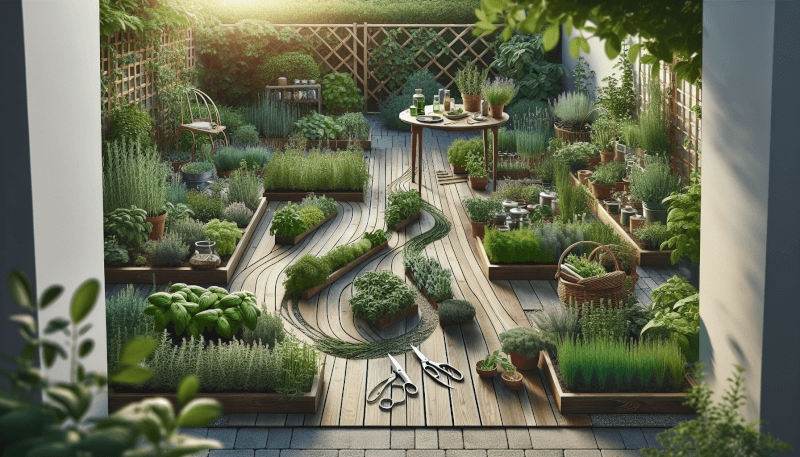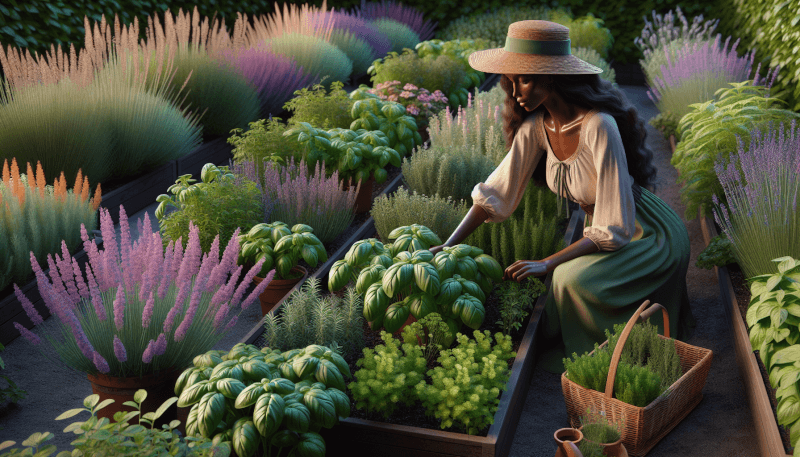Imagine stepping outside your home and being greeted by the delightful aroma of fresh herbs. Picture yourself effortlessly plucking basil leaves and dill sprigs to elevate your favorite dishes. With our expert tips and guidance, you can transform your outdoor space into a stunning herb garden that not only adds beauty to your surroundings but also provides a bountiful supply of flavorful herbs for your culinary creations. From choosing the right location to deciding which herbs to grow, we’ll walk you through every step of the process, ensuring that your herb garden becomes a thriving oasis of both aesthetics and functionality. So, roll up your sleeves and get ready to embark on a journey towards herbal bliss.

Choosing the Right Location
Consider the Sunlight
When choosing a location for your herb garden, it is important to consider the sunlight requirements of different herbs. Most herbs require at least six hours of sunlight per day, so choose a spot that receives ample direct or indirect sunlight. Observe your garden throughout the day to determine which areas receive the most sunlight. This will help you decide where to plant sun-loving herbs such as basil, rosemary, and thyme.
Evaluate the Soil
The quality of the soil in your chosen location is crucial for the success of your herb garden. Herbs thrive in well-draining soil that is rich in organic matter. Before you start planting, evaluate the soil’s texture and fertility. Sandy soil tends to drain quickly, while clay soil holds more moisture. It is ideal to have loamy soil, which is a combination of sand, silt, and clay. Add organic matter such as compost or aged manure to improve the soil’s texture and fertility.
Check for Drainage
Proper drainage is essential for the health of your herbs. Waterlogged soil can lead to root rot and other fungal diseases. Before planting, check the drainage of your chosen location. One simple way to do this is by digging a hole and filling it with water. If the water drains within an hour, the drainage is considered good. If it takes longer, you may need to amend the soil to improve drainage. This can be done by adding sand or perlite to the soil.
Planning the Layout
Decide on the Size and Shape
When planning the layout of your herb garden, consider the available space and your gardening goals. Determine the size and shape that best fits your needs. A small garden can be created in a raised bed or a few large pots, while a larger garden can have multiple raised beds or even a designated area in your yard. Consider how many herbs you want to grow and how much space each herb requires to grow effectively.
Consider Access and Pathways
It is important to consider access and pathways when planning the layout of your herb garden. You should be able to easily reach all your herbs for planting, watering, and harvesting. Plan pathways that allow you to navigate the garden without stepping on the plants. These pathways can be made of mulch, gravel, or stepping stones. By carefully considering the layout, you will create a functional and enjoyable herb garden.

Selecting Herbs
Research Different Herbs
Before selecting the herbs to grow in your garden, take the time to research different herbs and their specific requirements. Consider factors such as growing conditions, sunlight needs, and care instructions. Some herbs, like mint and lemon balm, are known to spread rapidly and may require containment. Others, like lavender and sage, are more drought-tolerant. By researching and understanding the characteristics of each herb, you can select the ones that are best suited for your garden and your needs.
Consider Culinary and Medicinal Uses
When selecting herbs, consider not only their culinary uses but also their medicinal properties. Many herbs have both culinary and medicinal applications. For example, basil is not only a flavorful addition to dishes but also has antibacterial properties. Rosemary is not only a savory herb but also has anti-inflammatory properties. By considering both culinary and medicinal uses, you can create a versatile herb garden that adds flavor to your meals and supports your health and well-being.
Preparing the Soil
Remove Weeds and Grass
Before planting your herbs, it is important to remove any weeds or grass that may compete for nutrients and space. Clear the area of any unwanted vegetation by hand-pulling or using a garden tool like a hoe or rake. Make sure to remove the entire root system to prevent regrowth. By starting with a weed-free soil, you give your herbs a better chance to thrive.
Loosen the Soil
Once the area is clear of weeds and grass, it is important to loosen the soil. This helps create a suitable environment for root development and allows water and nutrients to penetrate the soil more easily. Use a garden fork or a tiller to break up compacted soil. Work the tool to a depth of 8-12 inches, being careful not to overwork the soil. Loosening the soil will improve aeration and drainage, promoting healthy growth for your herbs.
Improve Drainage
In addition to loosening the soil, you may need to improve drainage if your chosen location has heavy or clay soil. Adding organic matter such as compost or aged manure will help improve the soil’s structure and drainage ability. Spread a layer of organic matter over the soil and mix it in using a garden fork or a tiller. This will enhance the soil’s water-holding capacity while still allowing excess water to drain away.

Starting from Seeds or Transplants
Advantages and Disadvantages of Seeds
Starting your herb garden from seeds offers numerous advantages. It allows for a wider variety of herb choices, as seeds are readily available for a wide range of herbs. Additionally, growing herbs from seeds can be more cost-effective, as seeds are generally cheaper than transplant plants. However, starting from seeds requires more time and patience, as it takes longer for the herbs to grow and mature.
Advantages and Disadvantages of Transplants
Using transplants, or already-grown herb plants, can be a convenient option for those who prefer quicker results. Transplants are typically sold in small pots and can be directly planted into your garden. This method ensures that you have established plants ready to grow and harvest. However, the variety of herb choices may be limited compared to starting from seeds, and transplant plants are generally more expensive.
Planting and Spacing
Follow Planting Guidelines
When planting your herbs, it is important to follow the planting guidelines specific to each herb. Some herbs, like dill and cilantro, prefer to be planted directly in the garden, while others, like lavender and rosemary, prefer to be started in pots and then transplanted. The planting depth and spacing requirements may also vary between herbs. By following the specific guidelines for each herb, you ensure that they have enough space to grow and thrive.
Determine Proper Spacing
Proper spacing is crucial for the health and development of your herbs. Crowded plants can lead to poor airflow, increased moisture retention, and a higher risk of disease. Each herb has its own recommended spacing requirements, which can typically be found on the seed packet or plant tag. As a general rule, most herbs should be spaced about 12-18 inches apart. However, be sure to adjust spacing based on the specific needs of each herb.

Providing Adequate Water
Watering Requirements
Proper watering is essential for the growth and vitality of your herb garden. Different herbs have varying watering needs, so it is important to understand their requirements. Most herbs prefer a consistently moist but not overly wet soil. As a general rule, water your herbs when the top inch of soil feels dry to the touch. During hot summer months, your herbs may require more frequent watering, while during cooler periods, watering can be reduced.
Choosing the Right Watering Method
The method you choose for watering your herb garden can also impact the health and growth of your herbs. A gentle watering system is recommended to avoid damaging the delicate herbs and causing soil erosion. Consider using a watering can, a soaker hose, or a drip irrigation system. These methods ensure a slow and steady release of water, allowing it to penetrate the soil deeply and reach the roots of your herbs.
Fertilizing Your Herb Garden
Importance of Nutrients
Just like any other plants, herbs require essential nutrients for healthy growth. Fertilizing your herb garden provides the necessary nutrients to promote strong root development, lush foliage, and bountiful harvests. The three main nutrients that herbs need are nitrogen (N), phosphorus (P), and potassium (K). Nitrogen promotes leafy growth, phosphorus aids in flower and fruit development, and potassium enhances overall plant health and disease resistance.
Choosing the Right Fertilizer
When selecting a fertilizer for your herb garden, it is important to choose a balanced formula that provides a mix of nitrogen, phosphorus, and potassium. Look for a fertilizer labeled with an N-P-K ratio that is suitable for herbs. A general-purpose organic fertilizer or a slow-release granular fertilizer can both be good options. Follow the manufacturer’s instructions for application rates and frequency, and be sure to apply the fertilizer evenly around the base of your herbs.

Mulching to Conserve Moisture
Benefits of Mulching
Mulching your herb garden provides numerous benefits, including conserving moisture, suppressing weed growth, and regulating soil temperature. Mulch acts as a protective layer on the soil surface, reducing evaporation and helping to retain moisture in the soil. This is especially beneficial during hot and dry periods. Mulch also prevents weed seeds from germinating and competing with your herbs for nutrients and space.
Selecting the Right Mulch Material
When selecting a mulch material for your herb garden, choose one that suits your needs and preferences. Organic mulches like straw, wood chips, or shredded leaves break down over time, improving soil structure and fertility. Inorganic mulches like gravel or stone do not break down but provide long-lasting weed control. Consider the appearance, availability, and functionality of the mulch material. Apply a layer of mulch around your herbs, keeping it a few inches away from the stems to prevent rot.
Controlling Weeds and Pests
Effective Weed Control Methods
Weeds can quickly overtake your herb garden, competing for resources and potentially suffocating your herbs. To effectively control weeds, consider implementing several methods. Hand-pulling weeds as soon as they appear is one of the most effective and environmentally friendly methods. Using a hoe or a garden tool to cut down weeds at the soil surface can also be beneficial. Additionally, applying mulch or using landscape fabric can help suppress weed growth.
Organic Pest Control Options
Pests, such as aphids and caterpillars, can damage your herbs and hinder their growth. Organic pest control methods can help combat these unwanted visitors without the use of harmful chemicals. Encourage natural predators like ladybugs and lacewings by planting flowers that attract them. You can also make homemade insecticidal soap using water, liquid castile soap, and vegetable oil. Regularly inspect your herbs for signs of pests and take prompt action to avoid major infestations.
By following these comprehensive guidelines, you can create a beautiful and functional herb garden that provides you with an abundant supply of flavorful herbs for culinary delights and medicinal purposes. With careful planning, proper soil preparation, and attentive care, your herb garden will flourish and bring joy to your gardening experience. Happy herb gardening!


